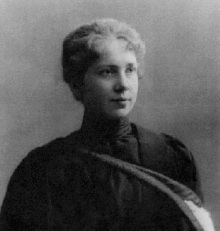Harriet Brooks
Harriet T. Brooks (born July 2, 1876 in Exeter , Ontario , † April 17, 1933 ) was a Canadian nuclear physicist . She was regarded by her contemporaries - alongside Marie Curie , Lise Meitner and Berta Karlik - as an outstanding woman in the field of radioactivity research .
Live and act
In 1898, Harriet Brooks graduated from McGill University in Montreal with excellent grades in Mathematics and Natural Philosophy ( BA ) at a time when many people believed women should not be admitted to universities. She then joined the research group led by the New Zealand-English physicist Ernest Rutherford in Montreal.
In 1901 she received a doctorate at Bryn Mawr College near Philadelphia , a women's college, but she ultimately did not write a doctoral thesis . She won a President's European Fellowship and joined Joseph John Thomson's research group in 1902 . There she completed her master’s degree.
In 1903 she returned to McGill University in Montreal. In 1904 she observed the 'recoil' phenomenon ( radioactive recoil ) for the first time , but misinterpreted it and was unable to verify it experimentally. It was not until the winter of 1908 that Otto Hahn succeeded in proving the radioactive recoil beyond any doubt in Berlin and published it in the Physikalische Zeitschrift in early 1909 . A little later, Lise Meitner and Hahn used recoil to work out a new method for producing radioactive decay products.
In 1904 Brooks got a position as a physics tutor at Bernard College in New York . In October 1906 she traveled to Europe with her Russian friends ( Maxim Gorki , Maria Adreyeva, Nicolai Burenin). In 1906/1907 she worked with Marie and Pierre Curie in Paris . In May 1907 she accepted an invitation from Ernest Rutherford to London .
On July 13, 1907, she married Frank Henry Pitcher . They moved to Montreal and had three children. Like many scientists of her time, she ended her research when she married. Harriet Brooks died on April 17, 1933 after a long illness ( leukemia ) at the age of 56.
Fonts (selection)
- with Ernest Rutherford: The New Gas from Radium . In: Transactions of the Royal Society of Canada . Volume 2, Volume 7, 1901, Section III, pp. 21-25. (on-line)
- with Ernest Rutherford: New Gas from Radium . In: The Chemical News and Journal of Physical Science . Volume 85, 1902, pp. 196-197.
- with Ernest Rutherford: Comparison of the Radiations from Radioactive Substances . In: Philosophical Magazine . 6th episode, volume 4, number 19, 1902, pp. 1–23, doi: 10.1080 / 14786440209462814 .
literature
- Marelene F. Rayner-Canham, Geoffrey W. Rayner-Canham: Harriet Brooks: Pioneer Nuclear Scientist . McGill-Queen's Press, 1992, ISBN 0-7735-0881-3 .
- Marelene Rayner-Canham, Geoff Rayner-Canham: Harriet Brooks (1876-1933): Canada's First Woman Physicist . In: Physics in Canada / La Physique au Canada . Volume 61, number 1, 2005, pp. 29-32 ( PDF ).
- Milorad Mlađenović: The History of Early Nuclear Physics: (1896–1931) . World Scientific, 1992, ISBN 981-02-0807-3 , p. 73.
- Marilyn Ogilvie, Joyce Harvey (Eds.): The Biographical Dictionary of Women in Science: Pioneering Lives from Ancient Times to the Mid-Twentieth Century . Volume 1, Taylor & Francis, New York / London 2000, ISBN 0-415-92039-6 , pp. 184-185.
Individual evidence
- ↑ Otto Hahn: About a new phenomenon in activation with actinium . In: Physikalische Zeitschrift. Vol. 10, No. 3, 1909, pp. 81-88.
- ^ Otto Hahn, Lise Meitner: A new method for the production of radioactive decay products; Thorium D, a short-lived product of thorium . In: Negotiations of the German Physical Society. XI, 1909, pp. 55-62.
| personal data | |
|---|---|
| SURNAME | Brooks, Harriet |
| ALTERNATIVE NAMES | Brooks, Harriet T. |
| BRIEF DESCRIPTION | Canadian nuclear physicist |
| DATE OF BIRTH | July 2, 1876 |
| PLACE OF BIRTH | Exeter, Ontario , USA |
| DATE OF DEATH | April 17, 1933 |
